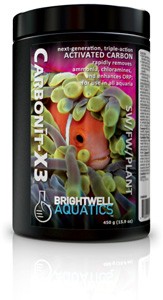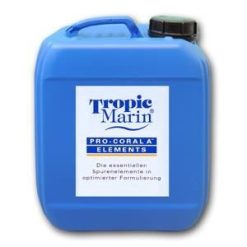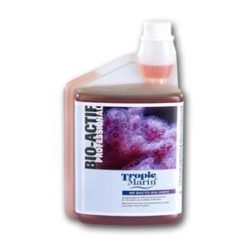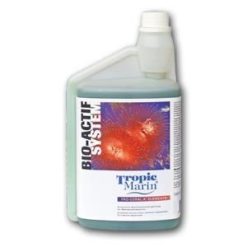

Triple-Action Activated Carbon Rapidly Removes Ammonia, Chlorines & Enhances ORP.

Overview
Next-generation, enhanced activated carbon, offering superior chemical filtration
characteristics to traditional activated carbon.
Triple-action removes ammonia, chloramines, and latent organic material, and then
facilitates decomposition and oxidation/reduction reactions, enhancing oxidation-reduction potential (ORP), and promoting water quality.
characteristics to traditional activated carbon.
Triple-action removes ammonia, chloramines, and latent organic material, and then
facilitates decomposition and oxidation/reduction reactions, enhancing oxidation-reduction potential (ORP), and promoting water quality.
Features high capacity for organic removal, high Iodine number, and minimal dust.
Average particle size encourages optimal flow and effectiveness.
Sizes
225g | 450g
Average particle size encourages optimal flow and effectiveness.
Sizes
225g | 450g
Technical Background
“Activated carbon” is a catch-all name for products that may be derived from coal, wood, or coconut shell, and which have undergone treatment (“activation”) to increase their porosity; the porosity and average pore size of the material is largely responsible for the effectiveness that it will have with regards to removing dissolved organic material from water and vapor. Contrary to claims made by manufacturers/suppliers of activated carbon, trace and minor elements are both actively- and passively-removed by any quality activated carbon; in the case of the former, this is due to gaps in the pores that are partially blocked by large molecules, into which trace and minor elements can pass and become trapped, and in the case of the latter, this is a result of these elements being trapped in binding sites on the large organic molecules, themselves, which are then removed by the carbon. Therefore, supplementation of trace and minor elements should take place after carbon use. Some hobbyists prefer to utilize activated carbon in their aquaria on a full-time basis, while others choose to employ it only when attempting to remove some sort of undesirable substance, such as an abundance or organic material or a medication. There are arguments to support both methods of use, therefore it is up to each individual hobbyist to determine what will work best for their aquaria. In general, freshwater aquaria, which do not have the benefit of protein skimming, can benefit from full-time use of activated carbon, whereas marine aquaria employing protein skimming may benefit more from only occassional carbon use.
“Activated carbon” is a catch-all name for products that may be derived from coal, wood, or coconut shell, and which have undergone treatment (“activation”) to increase their porosity; the porosity and average pore size of the material is largely responsible for the effectiveness that it will have with regards to removing dissolved organic material from water and vapor. Contrary to claims made by manufacturers/suppliers of activated carbon, trace and minor elements are both actively- and passively-removed by any quality activated carbon; in the case of the former, this is due to gaps in the pores that are partially blocked by large molecules, into which trace and minor elements can pass and become trapped, and in the case of the latter, this is a result of these elements being trapped in binding sites on the large organic molecules, themselves, which are then removed by the carbon. Therefore, supplementation of trace and minor elements should take place after carbon use. Some hobbyists prefer to utilize activated carbon in their aquaria on a full-time basis, while others choose to employ it only when attempting to remove some sort of undesirable substance, such as an abundance or organic material or a medication. There are arguments to support both methods of use, therefore it is up to each individual hobbyist to determine what will work best for their aquaria. In general, freshwater aquaria, which do not have the benefit of protein skimming, can benefit from full-time use of activated carbon, whereas marine aquaria employing protein skimming may benefit more from only occassional carbon use.
Instructions and Guidelines
Prior to first use, rinse under a stream of fresh water. Each 225 g of CARBONĪT-X3 is suited to efficiently filtering up to 225 US-gallons (~852 L) of water. The method in which CARBONĪT-X3 is employed will dictate reaction time with the water and consequently the rate at which organic material will be extracted; therefore, the greater the reaction time between carbon particles and water, the faster this process will occur. See opposite panel for additional instructions.
Prior to first use, rinse under a stream of fresh water. Each 225 g of CARBONĪT-X3 is suited to efficiently filtering up to 225 US-gallons (~852 L) of water. The method in which CARBONĪT-X3 is employed will dictate reaction time with the water and consequently the rate at which organic material will be extracted; therefore, the greater the reaction time between carbon particles and water, the faster this process will occur. See opposite panel for additional instructions.
The use of a mechanical pre-filter to remove particulate organic material from water prior to its interaction with this media will prolong effectiveness. Begin with 1g per 20 US-gallons in the system per week and adjust this ratio as conditions dictate. In high-nutrient aquaria, replace after 24-hours of total use; placement in lower-nutrient aquaria may be extended up to 48-hours of total use. Aquarist may choose to employ CARBONĪT-X3 for 1 – 2 hours each day throughout the course of a 1-month period to help improve water quality. If used in this fashion, CARBONĪT-X3 should be discarded and replaced at the conclusion of each month. Regardless of the method of application, slowing the flow of water through the media will improve its effectiveness.
Canister filtration: Load carbon into filter cartridge as directed by filter manufacturer. Passive filtration: Place CARBONĪT-X3 loosely in an 800μm mesh filter bag and locate in an area of low- to medium-flow. Turning bag over once during usage will serve to shift the carbon particles and increases effectivness of this method.
Note: CARBONĪT-X3 is not a tradtitional form of activated carbon; it is far more effective per unit mass at removing dissolved organic material, and while it may be employed continuously, aquarists may prefer a traditional form of activated carbon, such as Brightwell Aquatics CARBONĪT-P, for general use. CARBONĪT-P rapidly removes latent organic material from aquaria, however cannot remove ammonia and chloramines, and does not directly facilitate higher ORP as CARBONĪT-X3 does.
Caution: Keep out of reach of children. Not for human consumption.









